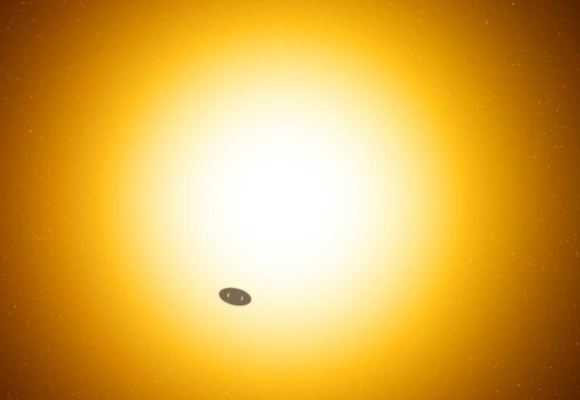Super-Puff Exoplanets May Actually Have Huge Ring Systems | Astronomy – Sci-News.com
Super-puffs, an intriguing, growing class of exoplanets, are the objects with exceptionally large radii for their masses and thus correspondingly low densities. According to new research, some of these exoplanets may actually have rings; three super-puffs — Kepler-87c, Kepler-177c and HIP 41378f — are especially good candidates for rings.

An artist’s conception of a ringed planet transiting in front of its host star. Image credit: Robin Dienel / Carnegie Institution for Science.
“We started thinking, what if these planets aren’t airy like cotton candy at all,” said Dr. Anthony Piro, an astrophysicist at the Carnegie Institution for Science.
“What if the super-puffs seem so large because they are actually surrounded by rings?”
In our own Solar System, all of the gas and ice giant planets have rings, with the most well-known example being the majestic rings of Saturn.
But it has been difficult for astronomers to discover ringed planets orbiting distant stars.
The radii of exoplanets are measured during transits — when the exoplanet crosses in front of its host star causing a dip in the star’s light. The greater the size of the dip, the larger the exoplanet.
“We started to wonder, if you were to look back at us from a distant world, would you recognize Saturn as a ringed planet, or would it appear to be a puffy planet to an alien astronomer?” said Shreyas Vissapragada, a graduate student in planetary sciences at Caltech.
To test this hypothesis, the researchers simulated how a ringed exoplanet would look to an astronomer with high-precision instruments watching it transit in front of its host star.
They also investigated the types of ring material that could account for observations of super-puffs.
Their work demonstrated that rings could explain some, but not all, of the super-puffs that NASA’s Kepler mission has discovered so far.
“These planets tend to orbit in close proximity to their host stars, meaning that the rings would have to be rocky, rather than icy,” Dr. Piro said.
“But rocky ring radii can only be so big, unless the rock is very porous, so not every super-puff would fit these constraints.”
A paper on the findings was published in the Astronomical Journal.
_____
Anthony L. Piro & Shreyas Vissapragada. 2020. Exploring Whether Super-puffs can be Explained as Ringed Exoplanets. AJ 159, 131; doi: 10.3847/1538-3881/ab7192






